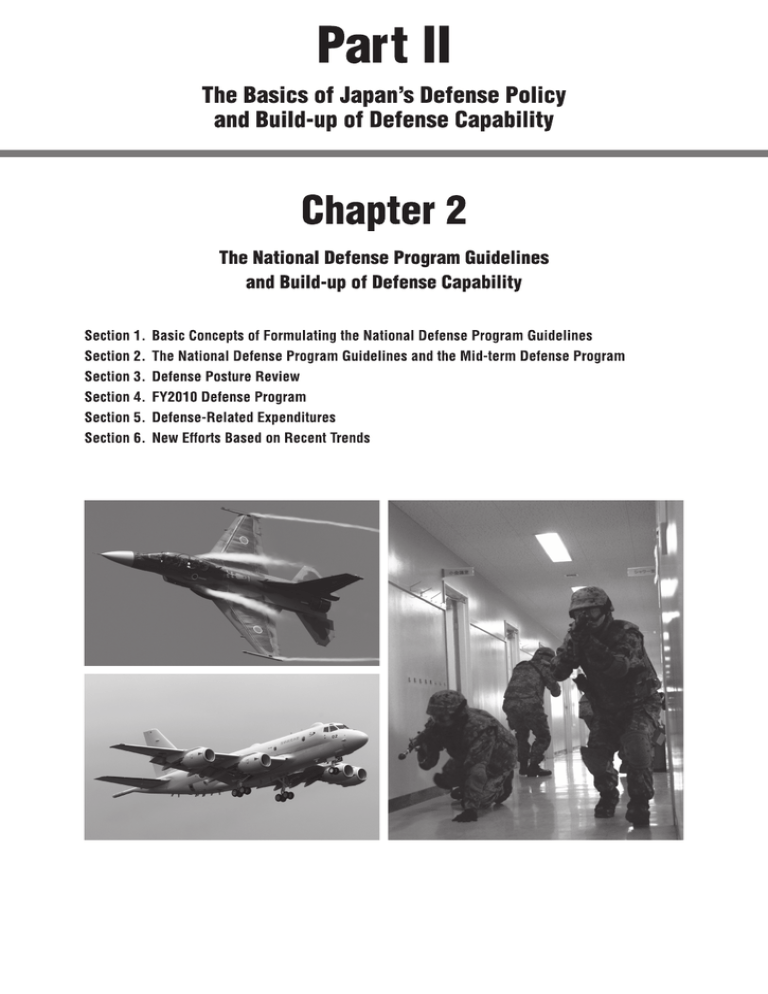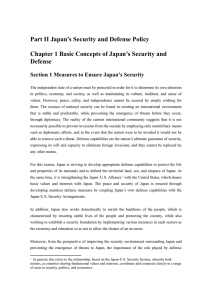Document 11050217
advertisement

— 144 — Part II The Basics of Japan’s Defense Policy and Build-up of Defense Capability — 145 — Fig. II-2-1-1 Relations between Two Objectives and Three Approaches � Two objectives for Japan’s security 1. To prevent or repel threats from directly reaching Japan 2. To prevent threats from reaching Japan by improving the international security environment � Three approaches for achieving the objectives Japan’s own efforts Cooperation with Japan’s alliance partners Cooperation with the international community Integrated combination Achievement of the objectives — 146 — Part II The Basics of Japan’s Defense Policy and Build-up of Defense Capability Fig. II-2-1-2 Changes in Conception of Defense Force that Should be Retained [Background] 1976 National Defense Program Outlines (NDPO) (October 29, 1976, National Defense Council –Approved by the Cabinet) � International tensions alleviated though the Cold War continued � Established balance among the U.S., China, and Russia in areas around Japan � The need to notify citizens of the defense capability goal [Background] 1995 National Defense Program Outlines (NDPO) (November 28, 1995, Security Council meeting –Approved by the Cabinet) � The end of the Cold War � International affairs with unclear and uncertain elements � Public expectations regarding international contributions [Background] 2004 National Defense Program Guidelines (NDPG)¹ (December 10, 2004, Security Council meeting –Approved by the Cabinet) � New threats such as international terrorism and ballistic missiles � Direct correlation between world peace and Japan’s peace � The need for a shift from emphasizing the deterrence effect to response capabilities Note 1: The National Defense Program Guidelines for FY2005 and beyond Basic Defense Force Concept Adhere fundamentally to Basic Defense Force Concept � National defense � Response to diverse situations such as large-scale disasters � Contribution to building a more stable security environment Succeed effective parts [Defense Force that Should be Retained] (1977 Defense White Paper) � Aiming to retain a steady position in deployment and structure including the logistics support structure while also preparing various functions necessary for defense � While being sufficiently alert in ordinary times, being able to effectively react to small and limited invasions � Sufficient foresight to be able to smoothly switch to new postures in cases where there is a critical change in international affairs [Basic Concept of Defense Force that Should be Retained] (1996 Defense White Paper) � Instead of directly responding to military threats against Japan, retaining the necessary minimum defense force as an independent country as to not create a power vacuum and cause instability in neighboring areas � Aiming at being equipped with the necessary functions for defense and retaining a balanced posture in deployment and structure including the logistics structure [Desired Role of the Defense Force in a New Security Environment] Effectively respond to new threats and diverse situations Proactive involvement in international peace cooperation activities on Japan’s own initiative Consideration of decline of youth population, financial circumstances Multifunctional, Flexible, and Effective Defense Capabilities (Effective Response-Oriented concept) � Equipped with high responsiveness, flexibility, and multipurpose functionality, and supported by advanced technology and intelligence capabilities in line with trends in military technology standards � More productive with limited resources through efficiency and rationalization of personnel, equipment, and operations — 147 — — 148 —

